Home interiors with decorations ideas transform ordinary rooms into stylish, comfortable, and functional spaces. By combining furniture, colors, textures, and accessories thoughtfully, homeowners can create a home that reflects their personality while remaining practical. Moreover, good interior decoration improves mood, enhances the functionality of spaces, and makes homes more inviting. Consequently, it is essential to plan and implement decoration ideas that suit both lifestyle and aesthetics.

Benefits of Decorating Home Interiors
Decorating home interiors provides multiple advantages. First, it enhances the visual appeal of a house, creating a welcoming environment for residents and visitors alike. In addition, proper decoration improves functionality by organizing space efficiently. Furthermore, it boosts mental and emotional well-being, as attractive and orderly spaces reduce stress and promote relaxation. Overall, decorating interiors creates a harmonious balance between beauty, comfort, and practicality.
Economic Advantages
Well-decorated interiors can increase property value and appeal. Thoughtful furniture placement, color schemes, and accessory choices make homes more attractive to potential buyers. Additionally, investing in durable and versatile decor items reduces the need for frequent replacements, making decoration economically beneficial in the long term.
Environmental Advantages
Using eco-friendly materials, energy-efficient lighting, and sustainable furniture contributes to a greener home. Furthermore, repurposing or upcycling existing items reduces waste while adding unique character to interior spaces. Consequently, decorating with sustainability in mind supports both style and environmental responsibility.
Key Decorations Ideas for Home Interiors
Several decoration ideas can enhance home interiors, ranging from furniture placement to color schemes and accessories.
1. Furniture Arrangement
Proper furniture arrangement maximizes space and improves flow. Place larger pieces against walls to open central areas and create a sense of spaciousness. Additionally, use multi-functional furniture like storage ottomans or foldable tables to increase utility without clutter.
2. Color Schemes
Selecting the right color palette is essential for setting mood and style. Warm colors, such as reds and oranges, create cozy and inviting spaces. Conversely, cool colors, like blues and greens, promote relaxation and calm. By combining accent walls with neutral tones, homeowners can achieve balance and visual interest.
3. Textures and Materials
Incorporating varied textures adds depth and warmth to interiors. Use combinations of wood, metal, glass, and textiles to create contrast and tactile interest. For instance, a plush rug paired with wooden furniture and soft cushions adds comfort while remaining visually appealing.
4. Wall Decorations
Wall decorations, such as framed artwork, mirrors, and shelves, enhance both aesthetics and functionality. Mirrors reflect light and create the illusion of larger spaces, while artwork and decorative shelves showcase personality and style. Furthermore, floating shelves allow storage without occupying floor space.
5. Lighting
Lighting dramatically affects interior ambiance. Combine natural light, ceiling fixtures, table lamps, and accent lighting to create layered illumination. Moreover, energy-efficient LED lights reduce electricity consumption while maintaining brightness and warmth.
6. Accessories
Accessories like cushions, throws, plants, and vases personalize interior spaces. They add color, texture, and seasonal variation. Furthermore, accessories are easy to update or swap, allowing homeowners to refresh interiors without major renovations.
Tips for Creating Cohesive Interiors
Creating cohesive interiors ensures that decoration ideas work together harmoniously.
Planning and Zoning
Divide spaces into functional zones for living, dining, and working. This helps organize furniture and decor effectively while maintaining flow. Additionally, plan placement of focal points, such as artwork or feature furniture, to draw attention strategically.
Balancing Elements
Balance large and small furniture, bold and neutral colors, and various textures to create visual harmony. For example, pairing a statement sofa with minimalistic tables and subtle accessories ensures that the space feels complete without being overwhelming.
Seasonal Updates
Change accessories or add small decor items seasonally to keep interiors fresh and dynamic. Rotating cushions, throws, and plants is an easy and affordable way to refresh a room while maintaining a consistent style.
Incorporating Personal Touches
Include personal items, such as family photos, heirlooms, or travel souvenirs, to make spaces uniquely yours. These elements create emotional connection and warmth in every room.
Lifestyle and Wellness Benefits
Well-decorated home interiors improve quality of life. They create inviting spaces for family, relaxation, or entertaining guests. Additionally, aesthetically pleasing and organized rooms reduce stress, encourage productivity, and enhance overall well-being.
Challenges and Solutions
Challenges may include limited space, budget constraints, or difficulty choosing cohesive colors and styles. Solutions involve prioritizing key furniture, using multi-functional items, shopping second-hand, or consulting design resources. By planning strategically, these challenges can be overcome, resulting in beautiful and functional interiors.
Conclusion
Home interiors with decorations ideas help transform any living space into a stylish, comfortable, and functional environment. By focusing on furniture arrangement, color schemes, textures, wall decorations, lighting, and accessories, homeowners can create cohesive and inviting interiors. Additionally, planning, balancing elements, and incorporating personal touches enhance both aesthetic and functional appeal. Ultimately, decorating interiors improves well-being, supports sustainable practices, and creates homes that are beautiful, organized, and welcoming.









